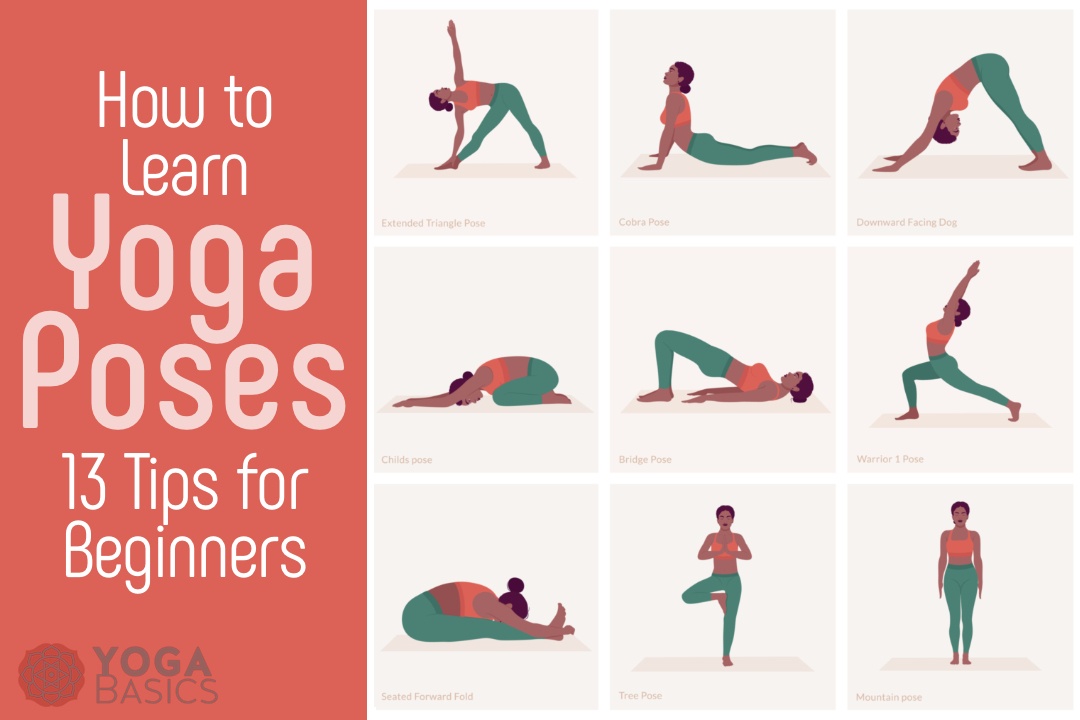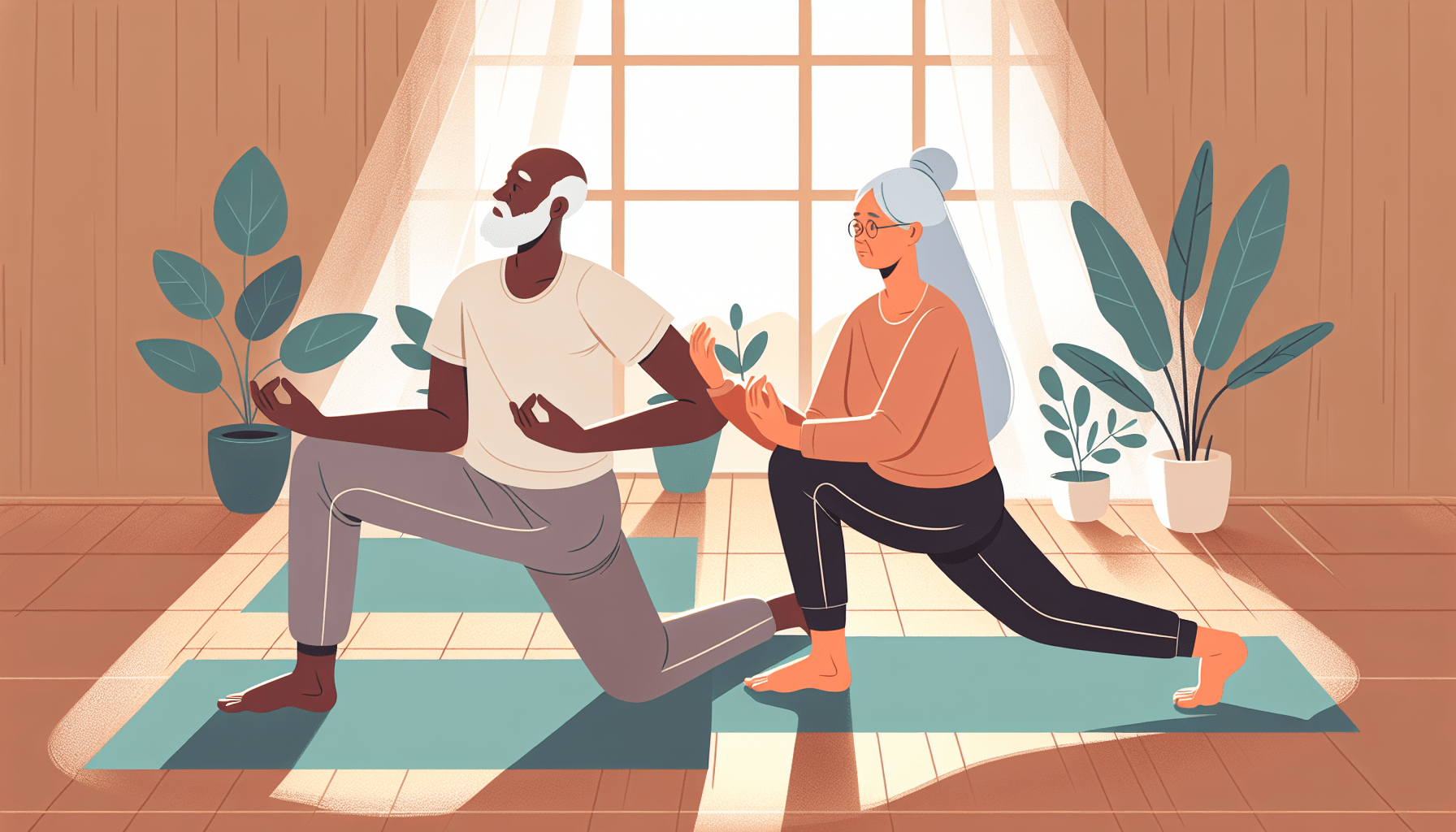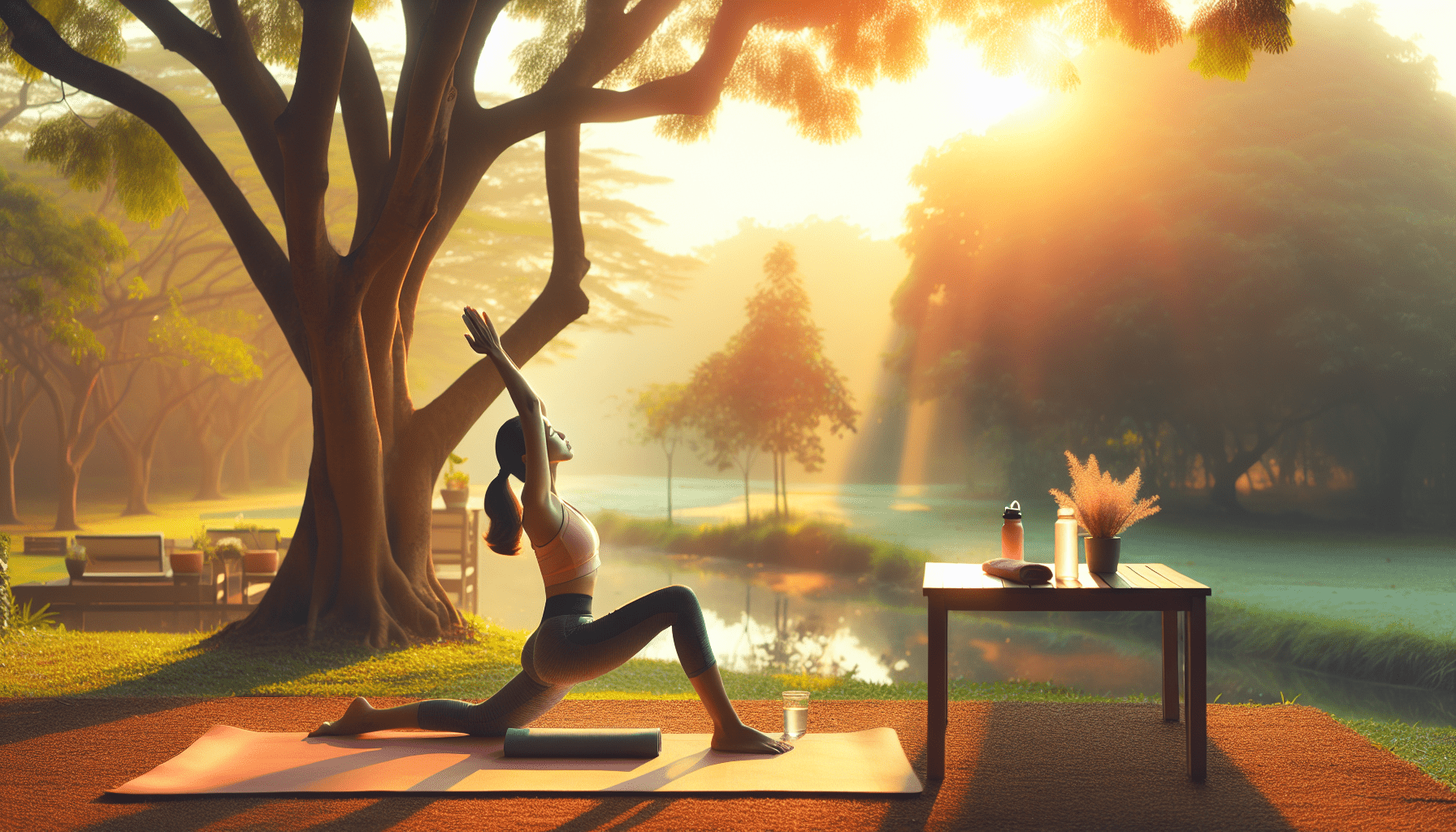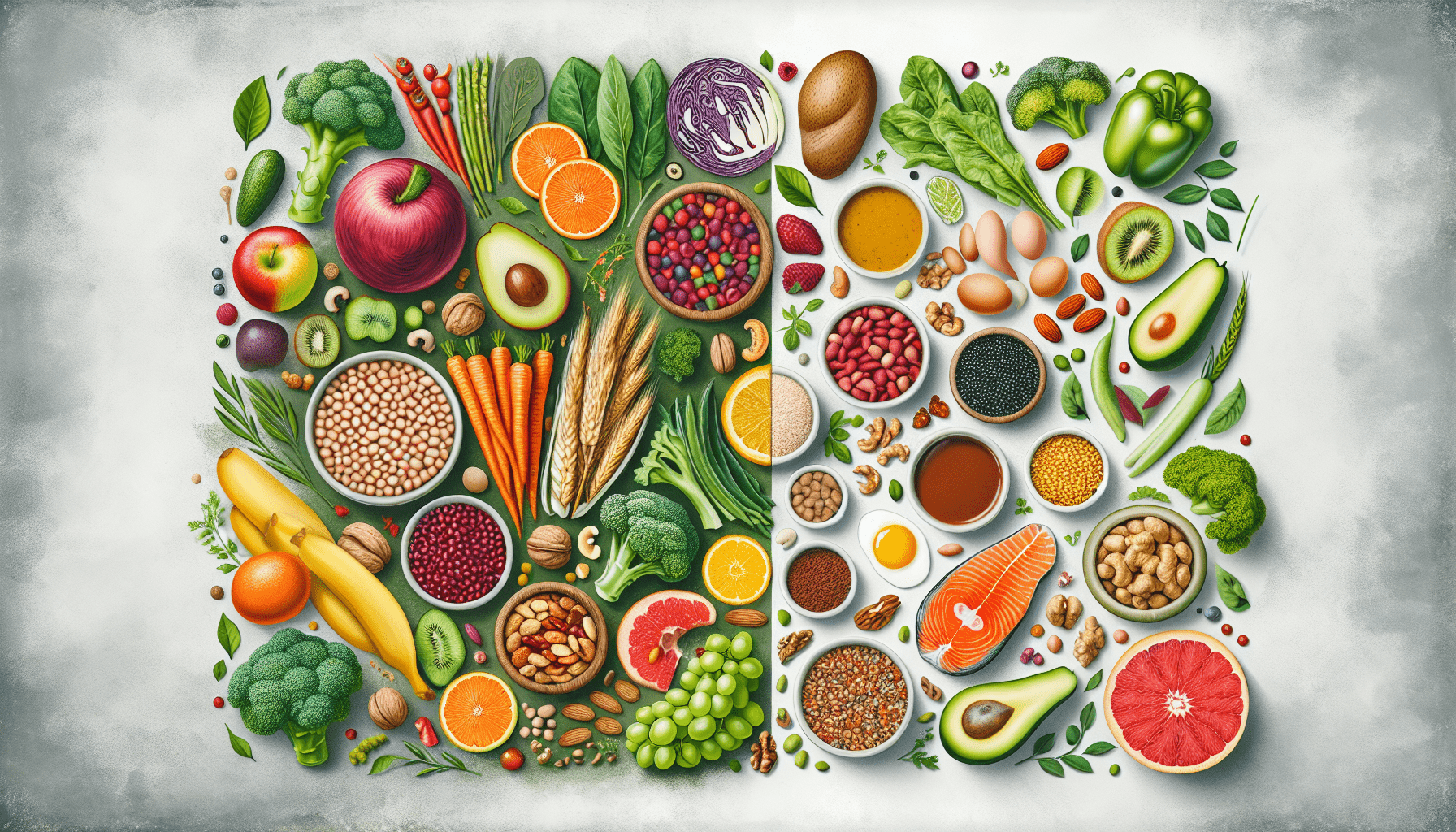Looking to start your journey into the world of yoga from the comfort of your own home? Look no further! This article will guide you through a series of beginner yoga routines that can easily be practiced in the tranquility of your living room. Whether you’re looking to enhance flexibility, build strength, or simply find a moment of peace, these routines are designed to gently introduce you to the fundamentals of yoga. So grab your mat, find a quiet space, and let’s embark on this fulfilling and rejuvenating journey together.
Setting Up a Yoga Space
When it comes to practicing yoga at home, setting up a dedicated space can make all the difference. Choose a quiet area where you can relax and focus without distractions. Ideally, this space should be clutter-free, allowing you to move freely during your practice. Clear away any obstacles such as furniture or loose items that may interfere with your movements.
Next, make sure to use a yoga mat for added comfort and stability. Yoga mats provide cushioning for your body and help prevent slipping during poses. Additionally, they create a boundary that defines your practice area. Consider investing in a high-quality mat that suits your needs and preferences.
Having props nearby can greatly enhance your practice, especially as a beginner. Blocks and straps are commonly used to modify poses and provide support. Blocks can be used to bring the floor closer to you, while straps help with stretching and reaching. These props can assist in achieving correct alignment and gradually improving flexibility. Keep them within reach, so you can easily incorporate them when needed.
Lastly, ensure that your yoga space is well-ventilated. Proper airflow is important for maintaining a comfortable temperature and preventing stuffiness. Open a window or use a fan to circulate fresh air throughout the room. This will not only make your practice more pleasant but also help you stay focused and energized.
Basic Yoga Equipment
As a beginner, it’s important to have the right equipment to support your yoga practice. Here are the essentials you’ll need:
-
Yoga mat: A high-quality mat provides the grip, cushioning, and stability necessary for your poses. Choose one that suits your preferences in terms of thickness, texture, and material.
-
Comfortable clothing: Wear breathable, stretchy clothing that allows for easy movement. Opt for materials like cotton or moisture-wicking fabrics that keep you cool and dry.
-
Props: Blocks, straps, and bolsters are great tools for beginners. Blocks help modify poses, straps assist with stretching, and bolsters provide support during restorative poses. Consider investing in these props to enhance your practice.

This image is property of avaana.com.au.
Practicing Proper Breathing Techniques
Breathing is a fundamental aspect of yoga, and learning proper techniques can greatly enhance your practice. Here are three breathing techniques to incorporate into your routine:
-
Deep belly breathing: Also known as diaphragmatic breathing, this technique involves inhaling deeply through your nose, allowing the breath to fill your belly, and exhaling slowly through your nose. Focus on expanding and contracting your abdomen with each breath. Deep belly breathing promotes relaxation and can help calm the mind and reduce stress.
-
Ujjayi breathing: Ujjayi, or “victorious,” breathing is characterized by a gentle, ocean-like sound created by slightly constricting the back of the throat. Inhale deeply through the nose, then exhale through the nose, creating a soft sound in the back of the throat. Ujjayi breathing helps build heat in the body, increases focus, and promotes a sense of calm.
-
Alternate nostril breathing: This technique involves blocking one nostril with your finger, inhaling through the other nostril, then switching nostrils and exhaling through the opposite side. Continue alternating nostrils with each breath. Alternate nostril breathing helps balance the right and left sides of the brain, promoting mental clarity and relaxation.
Remember to focus on your breath during your practice, allowing it to guide your movements and create a sense of flow.
Simple Warm-up Exercises
Before diving into your yoga practice, it’s important to warm up your body and prepare it for movement. Here are some simple warm-up exercises to incorporate:
-
Neck rolls and stretches: Gently roll your head from side to side, and then slowly bring your ear towards your shoulder, feeling the stretch on the opposite side of your neck. Repeat on the other side. This helps release tension in the neck and improves mobility.
-
Shoulder rolls: Roll your shoulders forward and backward in a circular motion, allowing the muscles to release and relax. This warms up the shoulders and upper back, promoting flexibility.
-
Wrist and ankle rotations: Rotate your wrists and ankles in clockwise and counterclockwise directions to loosen the joints and increase mobility. This is especially beneficial for those who spend a lot of time typing or sitting at a desk.
-
Gentle spinal twists: Sit on the edge of your mat and gently twist your torso to one side, placing your hand on the opposite knee for support. Repeat on the other side. This helps warm up the spine and release tension in the lower back.
-
Knee hugs: Lie on your back, hug your knees into your chest, and gently rock side to side. This releases tension in the lower back and stretches the glutes.
These warm-up exercises ensure that your muscles are properly prepared for the yoga poses ahead, reducing the risk of injury and allowing for a more effective practice.

This image is property of i.pinimg.com.
Essential Beginner Yoga Poses
As a beginner, it’s important to start with foundational yoga poses that build strength, flexibility, and body awareness. Here are five essential poses to incorporate into your practice:
-
Mountain pose (Tadasana): Stand with your feet hip-width apart, grounding firmly into the mat. Lengthen your spine, relax your shoulders, and engage your core. This pose helps improve posture, balance, and body alignment.
-
Child’s pose (Balasana): Begin on your hands and knees, then slowly sit back on your heels and fold forward, extending your arms in front of you. Rest your forehead on the mat and allow your whole body to relax. Child’s pose is a resting posture that helps release tension in the back, hips, and shoulders.
-
Downward facing dog (Adho Mukha Svanasana): Start on your hands and knees, then lift your hips up and back, forming an inverted “V” shape with your body. Press your hands firmly into the mat and lengthen your spine. This pose strengthens the upper body, stretches the hamstrings and calves, and energizes the body.
-
Warrior pose (Virabhadrasana): Step one foot forward into a lunge position, with your front knee bent at a 90-degree angle and your back leg extended with the foot grounded. Keep your torso upright and extend your arms out to the sides, creating a “T” shape. Warrior pose builds strength in the legs, opens the hips, and improves balance.
-
Tree pose (Vrksasana): Start by shifting your weight onto one leg and place the sole of your other foot on the inner thigh or calf of the standing leg. Keep your hands at your heart center or extend them overhead. Tree pose improves balance, strengthens the legs, and cultivates focus and concentration.
These essential poses provide a solid foundation for your yoga practice and can be modified to suit your current level of flexibility and strength. Practice them regularly to build a strong yoga base.
Sequences for Flexibility
Flexibility is an important component of overall physical fitness, and yoga can help improve your range of motion and flexibility. Here are some sequences to incorporate into your practice:
-
Sun salutation A: This sequence is a flowing series of poses that stretches and strengthens the entire body. It includes poses such as mountain pose, forward fold, plank, and upward facing dog. Repeat this sequence several times to warm up the body and improve flexibility.
-
Sun salutation B: Similar to Sun Salutation A, this sequence adds in additional poses such as chair pose and warrior poses. Sun Salutation B builds strength, endurance, and flexibility in the legs and core muscles.
-
Sitting forward bend sequence: Sit on your mat with your legs extended in front of you, then slowly fold forward, reaching towards your toes or shins. Hold for a few breaths, then slowly release. Repeat this sequence several times to gradually increase flexibility in the hamstrings and lower back.
-
Supine spinal twist sequence: Lie on your back and draw one knee towards your chest. Use your opposite hand to guide your knee across your body, creating a gentle twist. Hold for a few breaths, then repeat on the other side. Supine spinal twists improve spinal mobility and release tension in the back and hips.
Incorporate these flexibility sequences into your regular practice to gradually increase your range of motion and improve overall flexibility.

This image is property of i.pinimg.com.
Sequences for Strength
Strength is another important aspect of a well-rounded yoga practice. Here are some sequences to help build strength:
-
Plank variations: Begin in a high plank position, with your hands directly under your shoulders and your body in a straight line. Hold for a few breaths, then transition to side plank by stacking one foot on top of the other and raising one arm towards the ceiling. Alternate between high plank and side plank to build strength in the core, arms, and shoulders.
-
Chair pose sequence: Start in a standing position, then bend your knees and lower your hips as if sitting in an imaginary chair. Keep your chest lifted and your weight in your heels. Hold chair pose for a few breaths, then transition to a standing forward fold. Chair pose sequence strengthens the legs and core muscles.
-
Bridge pose sequence: Lie on your back with your knees bent and your feet flat on the ground. Press into your feet and lift your hips towards the ceiling, creating a straight line from your shoulders to your knees. Hold bridge pose for a few breaths, then slowly lower back down. Bridge pose sequence strengthens the glutes, hamstrings, and core muscles.
-
Warrior flow: Flow between warrior I, warrior II, and warrior III poses. Warrior I involves stepping one foot forward into a lunge position, with your front knee bent at a 90-degree angle and your back foot turned out slightly. Warrior II involves extending your arms out to the sides, creating a “T” shape with your body. Warrior III involves balancing on one leg and extending the other leg straight back, parallel to the ground. Warrior flow builds strength in the legs, core, and arms.
Incorporate these strength-building sequences into your practice to challenge your muscles and improve overall strength and stability.
Sequences for Relaxation
Yoga is not only about physical movement and strength; it also offers a multitude of relaxation techniques to help you unwind and reduce stress. Here are some sequences for relaxation:
-
Gentle restorative yoga sequence: This sequence involves gentle, supported poses that promote deep relaxation and release tension in the body. Poses such as legs up the wall, supported forward fold, and reclining butterfly pose are commonly included in restorative yoga. Practice this sequence when you need to relax and rejuvenate.
-
Legs up the wall pose: Lie on your back and place your legs up against a wall, creating an L-shape with your body. Allow the wall to support your legs and relax into the posture. Legs up the wall pose promotes relaxation, improves circulation, and helps reduce swelling and fatigue in the legs.
-
Corpse pose with guided relaxation: Lie on your back with your arms by your sides, palms facing up. Close your eyes and allow your whole body to relax and release tension. Practice guided relaxation by focusing your attention on different parts of your body, consciously relaxing each area. Corpse pose is a deeply restorative posture that allows for complete relaxation and rejuvenation.
Incorporate these relaxation sequences into your regular practice, especially at the end of your sessions, to promote a sense of calm and balance in both your body and mind.

This image is property of i.pinimg.com.
Yoga Apps and Online Resources
If you’re looking for additional guidance and resources to support your home yoga practice, there are numerous apps and online platforms available. Here are some popular ones:
-
Yoga with Adriene: Adriene Mishler provides free yoga videos on her YouTube channel, offering a wide variety of practices for all levels, including beginners.
-
Down Dog: This app offers customizable yoga classes that adapt to your skill level, allowing you to personalize your practice and progress at your own pace.
-
Glo: Glo offers a range of online yoga classes taught by world-class instructors, catering to various levels and styles of yoga.
-
Daily Yoga: With a large library of video classes, Daily Yoga provides guided practices for all levels, as well as specialized programs and challenges to help you stay motivated.
Explore these resources to find the ones that resonate with you, and use them to enhance and expand your home yoga practice.
Staying Motivated
Maintaining a consistent yoga practice can sometimes be challenging, especially when practicing at home. Here are some tips to help you stay motivated:
-
Set realistic goals: Start with small, achievable goals to gradually build momentum and progress. Celebrate your achievements along the way to stay motivated and encouraged.
-
Create a routine and stick to it: Establish a regular yoga practice by setting aside dedicated time each day or week. Treat it as an important appointment with yourself and make it a non-negotiable part of your schedule.
-
Find an accountability partner or join a yoga community: Having someone to share your progress, challenges, and experiences with can provide support and motivation. Consider joining a local yoga studio or online community to connect with like-minded individuals who can help keep you accountable.
-
Celebrate small wins along the way: Recognize and celebrate the small milestones and improvements you make in your yoga practice. Whether it’s holding a pose for a few seconds longer or mastering a new breathing technique, every step forward is worth acknowledging and celebrating.
By following these tips and staying committed to your practice, you’ll continue to grow and evolve on your yoga journey, reaping the physical, mental, and emotional benefits that yoga has to offer.

This image is property of www.yogabasics.com.




